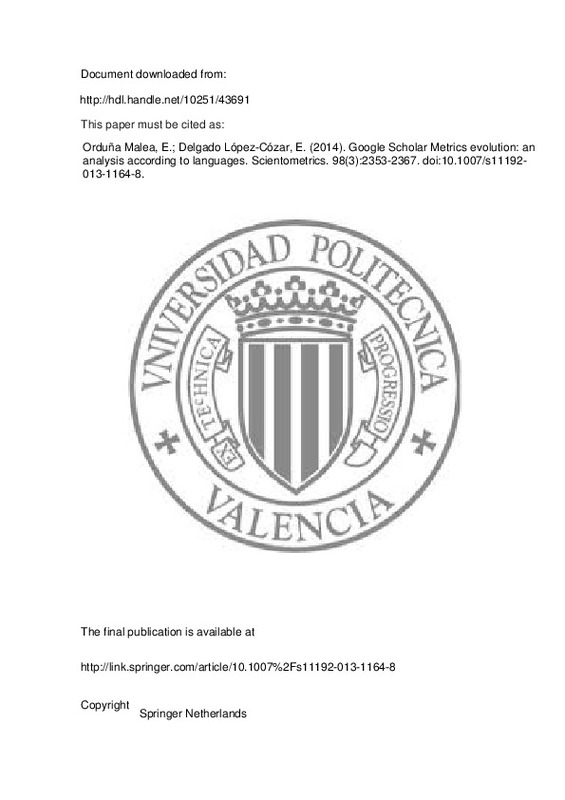Aguillo, & Isidro, F. (2012). Is Google Scholar useful for bibliometrics? A webometric analysis. Scientometrics, 91(2), 343–351.
Brewington, B. E., & Cybenko, G. (2000). How dynamic is the Web? Computer Networks, 33(1–6), 257–276.
Chen, X. (2010). Google Scholar’s dramatic coverage improvement five years after debut. Serials Review, 36(4), 221–226.
[+]
Aguillo, & Isidro, F. (2012). Is Google Scholar useful for bibliometrics? A webometric analysis. Scientometrics, 91(2), 343–351.
Brewington, B. E., & Cybenko, G. (2000). How dynamic is the Web? Computer Networks, 33(1–6), 257–276.
Chen, X. (2010). Google Scholar’s dramatic coverage improvement five years after debut. Serials Review, 36(4), 221–226.
Cho, Y. & Garcia-Molina, H. (2000). The evolution of the web and implications for an incremental crawler. Proceedings of the 26th International Conference on very large data bases, 200–209.
Costas, R., & Bordons, M. (2007). The h-index: advantages, limitations and its relation with other bibliometric indicators at the micro level. Journal of Informetrics, 1(3), 193–203.
de Winter, J. C. F., Zadpoor, A. A., & Dodou, D. (2013). The expansion of Google Scholar versus Web of Science: a longitudinal study. Scientometrics. doi: 10.1007/s11192-013-1089-2 .
Delgado López-Cózar, E., & Cabezas-Clavijo, A. (2012). Google Scholar Metrics: an unreliable tool for assessing scientific journals. El profesional de la información, 21(4), 419–427.
Delgado López-Cózar, E., & Cabezas-Clavijo, A. (2013). Ranking journals: could Google Scholar metrics be an alternative to journal citation reports and Scimago journal ranks. Learned publishing, 26(2), 101–114.
Fetterly, D., Manasse, M., Najork, M. & Wiener, J. (2003). A large scale study of the evolution of web pages. Proceedings of the Twelfth International Conference on World Wide Web, 669–678.
Harzing, A.-W. (2013). A preliminary test of Google Scholar as a source for citation data: a longitudinal study of Nobel prize winners. Scientometrics, 94(3), 1057–1075.
Jacsó, P. (2012). Google Scholar Metrics for Publications—The software and content feature of a new open access bibliometric service. Online Information Review, 36(4), 604–619.
Koehler, W. (2002). Web page change and persistence-4-year longitudinal web study. Journal of the American Society for Information Science and Technology, 53(2), 162–171.
Koehler, W (2004). A longitudinal study of Web pages continued a consideration of document persistence. Information Research, 9(2). http://informationr.net/ir/9-2/paper174.html . Accessed 1 Sep 2013.
Kousha, K., & Thelwall, M. (2007). Google Scholar Citations and Google Web/URL citations: a multidiscipline exploratory analysis. Journal of the American Society for Information Science and Technology, 58(7), 1055–1065.
Leydesdorff, L. (2012). World shares of publications of the USA, EU-27, and China compared and predicted using the new Web of Science interface versus Scopus. El profesional de la información, 21(1), 43–49.
Neuhaus, C., Neuhaus, E., Asher, A., & Wrede, C. (2006). The depth and breadth of Google Scholar: An empirical study. Libraries and the Academy, 6(2), 127–141.
Orduña-Malea, E., Serrano-Cobos, J., & Lloret-Romero, N. (2009). Las universidades públicas españolas en Google Scholar: presencia y evolución de su publicación académica web. El profesional de la información, 18(5), 493–500.
Orduña-Malea, E., Serrano-Cobos, J., Ontalba-Ruipérez, J.-A., & Lloret-Romero, N. (2010). Presencia y visibilidad web de las universidades públicas españolas. Revista española de documentación científica, 33(2), 246–278.
Ortega, J. L., Aguillo, I. F., & Prieto, J. A. (2006). Longitudinal study of contents and elements in the scientific Web environment. Journal of Information Science, 32(4), 344–351.
Payne, N., & Thelwall, M. (2007). A longitudinal study of academic webs: growth and stabilization. Scientometrics, 71(3), 523–539.
[-]







![[Cerrado]](/themes/UPV/images/candado.png)


